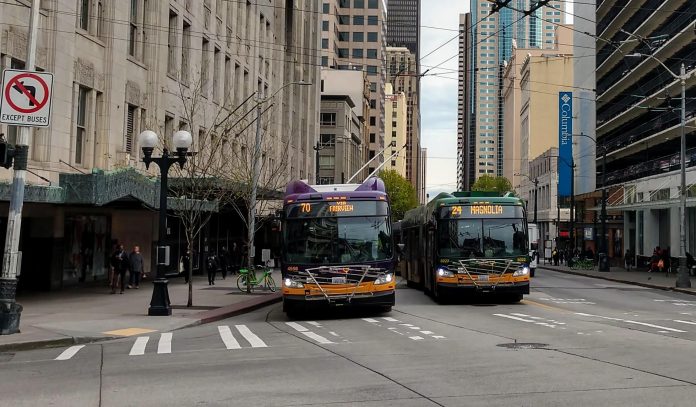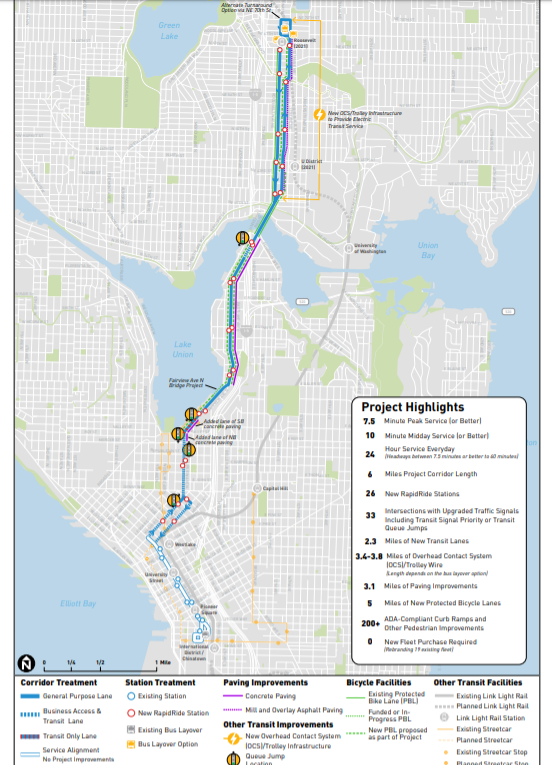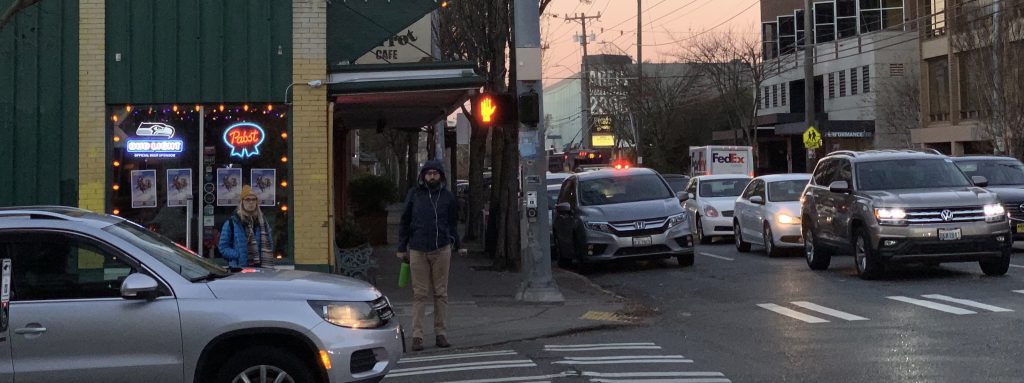
Despite rumors to the contrary, the Seattle Department of Transportation (SDOT) is still targeting a 2024 opening for RapidRide J Line, which will speed up the Route 70 bus, and is not planning to shift project funds to fill other budget holes, the agency confirmed on Monday.
Transit advocates were getting nervous after a constituent claimed a council staffer had said the RapidRide project was to be delayed and potentially shelved “a very long time” due to the budget crunch from the pandemic and costly emergency repairs needed for the West Seattle Bridge.
“The Seattle Department of Transportation is not planning to change our investment in the RapidRide J Line project or the protected bike lanes on Eastlake,” SDOT spokesperson Kari Tupper confirmed. “We do not anticipate that our response to the West Seattle High-Rise Bridge closure would have an impact on the separate RapidRide J project budget.”
That said, the Move Seattle levy, which already faced a “reset,” may need another one in reaction to the pandemic, which has slowed and complicated project delivery this year. “Any changes to Move Seattle project budgets will depend on the outcome of the 2021-2022 budget process,” Tupper said.
Pedersen’s take
This seemingly puts the ball back in the Seattle City Council’s court. Transportation Chair Alex Pedersen, whose office was allegedly the source of the J Line delay rumor, acknowledged SDOT controls the timing and has some of the funding set aside.
“SDOT is in control of the timing and existing funds for the proposed J line (Roosevelt Rapid Ride),” Pedersen said in an emailed response. “I strongly support the preservation and increase of public mass transit options throughout Seattle and led Council’s efforts to get a Seattle Transportation Benefit District [STBD] on the ballot for voters even during the Covid pandemic.”
While Chair Pedersen did bring forward Seattle Transportation Benefit District renewal legislation, he was the lone vote against an amendment boosting the size of the ballot package by 50%. During deliberations, he emphasized the need for bridge replacement citywide and the West Seattle Bridge as a pressing emergency that should alter priorities.
“As I understand it from SDOT, the process to put the proposed J line in place could be delayed by numerous factors including the COVID pandemic and the timing of the federal/state environmental review,” Pedersen said in an emailed response. “The Covid pandemic and massive budget deficits facing all levels of government are making it harder for SDOT to get all transportation projects on line as originally scheduled and we are faced with the additional challenge of the West Seattle Bridge crisis on top of a backlog of infrastructure maintenance projects.”
Given the voter-approved levy, commitment from SDOT, and what should be a highly competitive federal grant application, the project appears safe for now. Property tax levies are more resilient to economic downturns. What will happen with federal Small Starts grants over the next four years is anybody’s guess, but assuming a Joe Biden administration takes office, the timeliness and quantity of transit grants should improve.
“We have no reason to suspect that federal funding is at risk,” Tupper said. “While the City of Seattle 2021-22 budget setting process is an ongoing topic, we still expect to begin construction in the near future.”
RapidRide J improvements
The City projects the RapidRide J Line will more than double ridership in the corridor and is predicted to have a whopping 21,600 daily boardings in its first year of service. King County Metro reported Route 70 had 8,300 daily riders in fall 2017.

As we detailed earlier this year, “Plans call for about 60 additional bus trips each day, while reducing overcrowding and upping frequency to every 7.5 minutes at peak. SDOT expects on-time performance to greatly improve thanks to some key sections of bus lanes and smart traffic signals that give buses additional green lights–17 minutes faster at afternoon peak.”
RapidRide branding comes with upgraded bus stops and lighting, real-time arrival information on electronic displays, off-board payment, and all-door boarding. SDOT is planning 200 fresh curb ramps, sidewalk upgrades, overhead wire to electrify the whole route, and protected bike lanes on Eastlake Avenue.
Eastlake Avenue is key bike connection
Eastlake Avenue is a critical stretch that will provide safe biking connections between the University District and Downtown. Councilmember Alex Pedersen has kicked around moving the bike lane to a parallel route, despite that being an untenable solution, with Eastlake Avenue scoring highest on the SDOT’s corridor study.

Bike advocacy groups have stressed the importance of Eastlake Avenue to the bike network. SDOT has targeted late 2022 to open the Eastlake protected bike lanes, but the impacts of the recession and pandemic could affect that. The City hasn’t changed plans yet, though.
Near-term plans
The pandemic has been tough on King County Metro finances. Sales tax receipts have taken a nose dive and the agency has suspended fare collection as part of Covid precautions. Since sales tax is Metro’s primary revenue source, the recession presents a huge challenge; major cuts appear on the horizon without new funding.
At the Move Seattle Levy Oversight meeting yesterday boardmember Patrick Taylor (who is also a boardmember with The Urbanist) asked about the RapidRide J’s status, and an SDOT representative confirmed the agency is fully committed to the project, but did point to Metro’s budget crunch as a potential issue for the project. The Metro service hours and new red RapidRide buses the project was hoping to use may not be there in the planned quantities.
With bus ridership down 63% system-wide at last count, Metro has focused service on routes serving essential workers and transit-dependent populations.
“While King County Metro is currently prioritizing service to essential workers originating from South Seattle and those stranded due to the sudden closure of the failed West Seattle Bridge, North Seattle can look forward to Sound Transit’s soon-to-open light rail stations at Brooklyn Ave and Roosevelt opening next year, well before the target date for the J line opening,” Pedersen said. “In addition, King County Metro would ideally maintain and, if needed, increase service for Route 70.”
The Northgate Link extension will be a big upgrade for riders in the University District and Roosevelt, but most Eastlake riders will be anxiously awaiting RapidRide’s arrival for a marked improvement in service–notwithstanding a few Route 70 diehards.
Doug Trumm is publisher of The Urbanist. An Urbanist writer since 2015, he dreams of pedestrian streets, bus lanes, and a mass-timber building spree to end our housing crisis. He graduated from the Evans School of Public Policy and Governance at the University of Washington in 2019. He lives in Seattle's Fremont neighborhood and loves to explore the city by foot and by bike.

